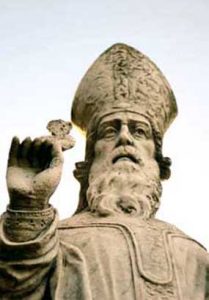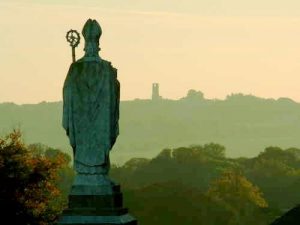This is a speech that I had to do for college a few years ago. On the off chance that you might find this interesting or you are doing a report, I thought I’d include it here for you.
Why did city officials in Chicago dump 40 pounds of chemicals into the Chicago river last month? The answer is easy – it was Saint Patrick’s Day and those chemicals were actually harmless green dye designed to enhance the celebration.
Have you ever wondered where all of the tradition comes from and who the man is that resulted in one day of every year when the entire country turns Irish for a day? The reality is actually quite surprising. Writings by Saint Patrick reveal a man that was full of kindness and humility. He was a wonderful role model because he was a man of peace who honored forgiveness and encouraged that in others. He overcame and survived a great deal. He became a great and loved leader despite being, as historian Phillip Freeman puts it, “a man filled with insecurities and doubt.”
Saint Patrick’s Day is widely celebrated throughout the United States. Cities such as Chicago, Cleveland and Boston hold huge celebrations, complete with parades and all the trimmings. On these days, the taverns and pubs are full of happy patrons drinking green beer. Perhaps you were one of them. Author Daniel Munoz notes that it is no surprise that the day commemorating the Patron Saint of Ireland was originally a holy day. In fact, most businesses in Ireland actually closed down for the day until around 1976, particularly those that served alcohol. It became a national holiday in the United States in 1903 and has grown substantially from that point. But who was the real man whose life led to these celebrations?
Legend surrounds Saint Patrick. One of the more popular beliefs is that he drove all the snakes from Ireland, though this is likely an inflated metaphor. Other common beliefs include that Saint Patrick was Irish – he was not, but we’ll talk about that again in a moment. Another belief was that Patrick was daring, entering contests of death with pagan Druids. This in also now believed to be rumors.
However, the reality of Saint Patrick’s life is actually much more interesting than rumors and lore.
Historian Phillip Freeman tells the story of the life of Saint Patrick in his biography of the saint, who actually was not Irish at all. Saint Patrick was born into a wealthy family in Britain and actually began life as an atheist, despite that fact that his family were believers and even held positions in the church. He was born between 390 and 400 A.D. – prior even to the technical classification of the middle ages or medieval times of Europe. He lived his life in wealth and comfort within the Roman Empire until he was 15. At that time, Patrick’s life took a drastic turn.
Patrick’s family had travelled to a nearby town, leaving the youth mostly alone in the house. As young Patrick slept in his bed one night, Irish pirates crept into his family home. He was bound and gagged before he awoke. Patrick, along with the servants, were taken captive. The prisoners were led away with chains around their necks. Any of the servants who could not keep up or fought the captors were killed outright.
And that began Patrick’s life as a slave. He was sold and entered into life as a shepherd. As if being sold into slavery wasn’t enough, the Romans had very distinct beliefs about the Irish. This must initially have terrified young Patrick, because at that time so called “experts” of the Roman Empire believed the Irish to be savages and even cannibals. Julius Ceasar referred to the land as “Hibernia” which means eternal winter. Life in Ireland at that time was both harsh and brutal. According to writer Amy Crawford, any man who was enslaved there was considered as good as dead.

Patrick spent six years in this life as a slave, at which time his faith gradually established in a land where Christianity did not really exist. Historian William Federer discusses how Patrick wrote that, in a dream, God told him he would soon return home. Shortly after, a ship appeared some distance away and he felt he heard the voice of God telling him that this would be his passage promised. And so he escaped and sought passage aboard ship, which turned out to be one of Irish pagan sailors, who at first turned him away, then called him back and granted him passage. This was how Patrick returned home. However, Patrick’s story was far from over.
Patrick’s family and friends were thrilled at his return. After a short celebration, Patrick set about filling his yearning for education and also became ordained.
Patrick was driven to return to Ireland to convert his captors. He petitioned his superiors in the church many times to be allowed to travel to Ireland. Prior missionaries to the land had simply disappeared – some in less than a year, so reluctance to send Patrick was understandable. Yet, eventually, he was granted his request.
When he embarked on his journey back to the land of his captors, he was 40 years old. He spent the next 30 years in Ireland, spreading the words of his belief to those who had enslaved him and killed his friends. He preached understanding with gentle methods and converted many of the inhabitants to the Christian faith. Where others had failed, Patrick converted entire kingdoms. Many believe he performed miracles in his travels and he founded many churches. He died in 461 at Saul, where he had built his first church.
So now we know of the transition of Saint Patrick’s day from holy day to holiday. We know that many common associations with Saint Patrick are likely inaccurate, but that the real man was actually more fascinating and inspiring than the myth.
In one of his final missives, Patrick wrote “I am Patrick, most unlearned….. and utterly despised by many.” Selfless sentiments such as this were common in Patrick’s writings. Yet, this man who was so humble and insecure, followed his dreams and his beliefs with a heart filled with kindness to those who were cruel to him. In return, He became one of the most well known and beloved men of the people of the country that enslaved him. He became the patron Saint of an entire country, though of course he did not know this would happen at the time of his death. His story is inspiring because even though he greatly lacked confidence in himself, he did great things. The celebration of his life has become a national holiday in more than one country and is a day of joy and happy festivities throughout the United States. His life and ways are inspiring to what can be achieved with kindness and love, even if we doubt ourselves.

Statue of St. Patrick at the Base of Croagh Patrick Mountain, County Mayo, Connacht, Ireland

